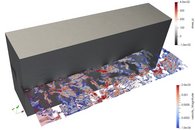Reaktive Reservoirsysteme – Lösung und Fällung von Salzen und die Auswirkungen auf die hydraulischen und mechanischen Gebirgseigenschaften - ReSalt
The aim of this research project is to gain a basic understanding of the temporal behavior of fracture-dominated reservoirs as well as the interaction between the chemical composition of the reservoir fluid and the physical boundary conditions of the reservoir (e.g. pressure and temperature) depending on the injection and production pressure. The results of the work will be used to improve the predictability and the process-related controllability of the reservoir behavior. The analysis and assessment of the permeability development under varying p / T conditions play a central role. The main focus of the investigations is the assessment of the permeability of fractured reservoirs and their change through thermal, mechanical and chemical interactions. The necessary experimental, analytical and numerical investigations are carried out using model systems and reference materials. The results of the laboratory examinations allow the parameterization and validation of numerical models, which ultimately enable a transfer to complex reservoir systems by means of scaling processes that are also to be developed.
The permeability of natural as well as artificially created fractures can be influenced by various processes. Therefore, sustainable production and thus energy production from e.g. stimulated geothermal reservoirs. The mechanical as well as the chemical influence of such fracture-matrix systems by laboratory tests and the measurement of the change in fracture permeability is therefore a goal of the subproject. In addition to a change in the hydraulic permeability of fractures due to chemical and mechanical alteration, the test series also include a change in the permeability by adjusting the pore pressure. Furthermore, innovative test setups are developed, with which fracture under shear stress can be offset relatively and also pure shear cracks parallel to the sample can be tested. The previously neglected fracture geometry is evaluated as an important factor in the tests using fracture surface measurements.
Reactive fluid-rock interactions can lead to significant changes in permeability in reservoirs. This applies in particular if strong pressure, temperature and salinity gradients are induced during the geothermal use of the subsurface. In this context, the precipitation of minerals in rock depends on the available pore space and can be quantified with laboratory experiments with regard to the chemical interaction and validated by means of adapted hydro-chemical coupling modules using modelling. So far there are no corresponding coupling modules with regard to fractured rocks. For this reason, the main goal is the development and validation of a method for the quantification of solution and precipitation reactions in fractured rocks. The results regarding reactive fluid-rock interactions and the resulting change in hydraulic permeability should be used to quantify the relevant processes. The resulting process understanding provides the basis for a scaling process to be developed further in the project, which can transfer the processes to the reservoir scale using simulations.
The following steps are planned to achieve this goal:
- Selection, sampling, preparation as well as physical and chemical characterization of relevant reservoir rocks / reservoir rock analogs.
- Flow-through experiments with defined reservoir fluids on complementary thermo-triaxial systems under controlled p / T reservoir conditions and analysis of changes in fluid chemistry and rock deformation.
- Quantification of the changes in rock properties resulting from solution-precipitation reactions with particular attention to reactive and mechanically induced changes in the hydraulic fracture permeability.
- Complementary characterization of the chemical and physical properties of the pore fluids.
- Microstructural analysis before and after loading and flow in the thermal triaxial system. Based on the fracture matrix geometry of the rock, which is determined by means of computer tomography (University of Mainz), mercury porosimetry and thin section analysis (GFZ), a 3D modelling of the fracture-matrix system is to be carried out.
- Thermo-Hydro-Mechanical-Chemical (THM-C) coupled modelling on sample scale for analysis and generalization of the influences on the reservoir properties.
- Scaling of fracture-matrix systems as well as the geomechanical and geochemical processes from the pore and laboratory scale to the reservoir scale.
Findings from the research project can be directly transferred to industrial applications and are used for further development. This ensures that the development of deep geothermal energy in Germany can be expanded sustainably and in the long term.



